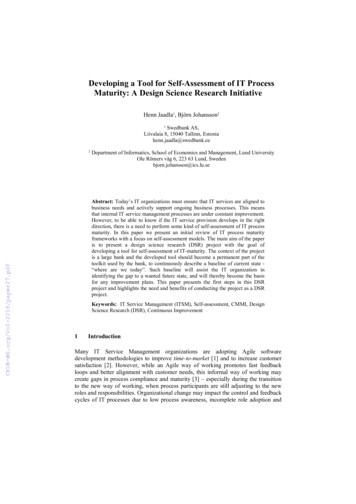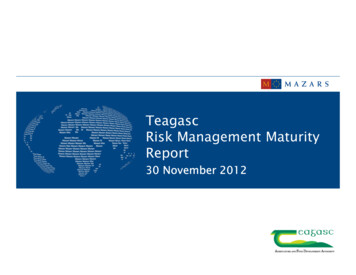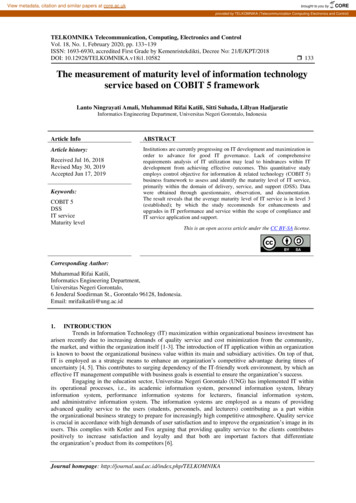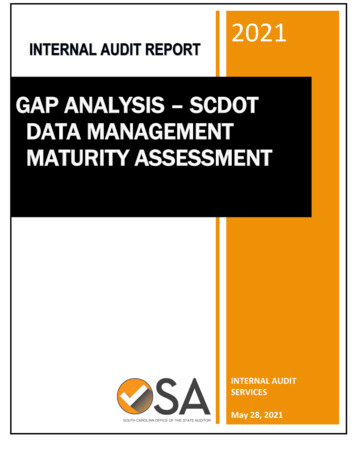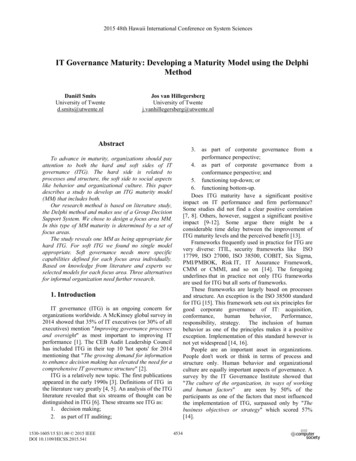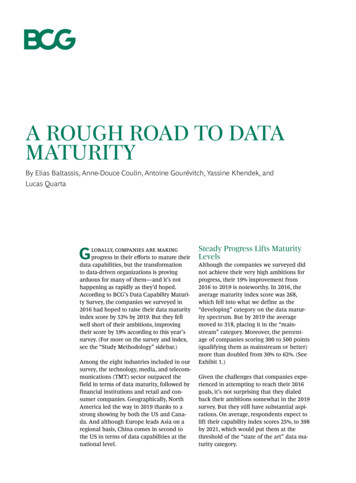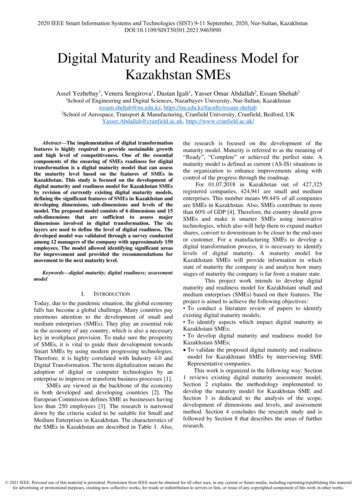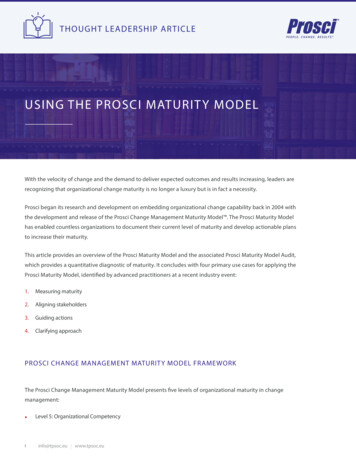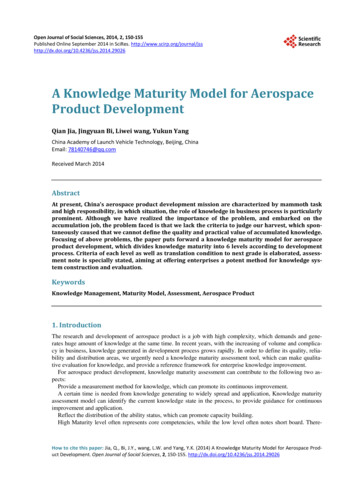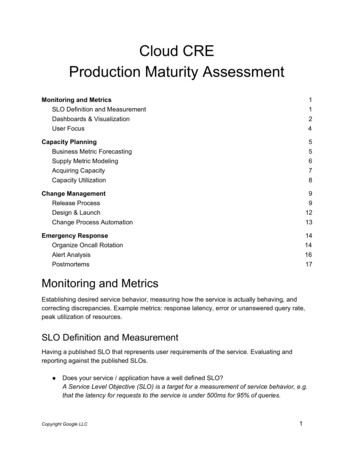
Transcription
Cloud CREProduction Maturity AssessmentMonitoring and Metrics1SLO Definition and Measurement1Dashboards & Visualization2User Focus4Capacity Planning5Business Metric Forecasting5Supply Metric Modeling6Acquiring Capacity7Capacity Utilization8Change Management9Release Process9Design & Launch1 2Change Process Automation1 3Emergency Response1 4Organize Oncall Rotation1 4Alert Analysis1 6Postmortems1 7Monitoring and MetricsEstablishing desired service behavior, measuring how the service is actually behaving, andcorrecting discrepancies. Example metrics: response latency, error or unanswered query rate,peak utilization of resources.SLO Definition and MeasurementHaving a published SLO that represents user requirements of the service. Evaluating andreporting against the published SLOs. Does your service / application have a well defined SLO?A Service Level Objective (SLO) is a target for a measurement of service behavior, e.g.that the latency for requests to the service is under 500ms for 95% of queries.Copyright Google LLC1
Does the SLO reflect the experience of customers?I.e., does meeting the SLO imply an acceptable customer experience? And conversely,does missing the SLO imply an unacceptable customer experience?Is the SLO published to users?This isn't common, but sometimes if you have a single big consumer of your service thenyou may publish your SLO so they can plan around your service's performance.Do you have well-defined measurements for the SLO? Is the measurement process documented? Is the measurement process automated?I.e., do you get reports or graphs for the SLO automatically, or do you have tomanually run a command or fill in a spreadsheet to see how well you are meetingthe SLO?Do you have a process for changing / refining the SLO?For instance, if you're consistently failing to meet your SLO but your users don't seem tobe complaining, how do you decide whether to change the SLO target level?Maturity Levels1 - UnmanagedService has no SLO or SLO does not represent user requirements.2 - ManagedService has defined SLOs. Service has measurement of SLO but it is ad hoc or undocumented.3 - DefinedService has defined SLOs. Measurement is a documented process with clear owner.4 - MeasuredSLO is published to users. SLO is measured automatically. SLO represents user requirements.5 - Continuous ImprovementOngoing evaluation and refinement of SLO with users.Dashboards & VisualizationClear presentation of data to support service management, decision making, and behaviormodification. Do you collect data about your service? Which collection methods do you use? Logs processingCopyright Google LLC2
White box MonitoringInspecting internal system state Black box MonitoringSynthetic transactions/probes that emulate real user requests Metrics collection from client devices Other Can you briefly describe your collection method(s)? Is the collection automated?Does your service have dashboards?A dashboard is typically a web page displaying graphs or other representation of criticalmonitoring information, allowing you to see at a glance how well your service isperforming.Do the dashboards contain key service metrics?E.g.: QPS, latency, capacity, error budget exhaustionDo the dashboards contain key business metrics?E.g.: visits, users, views, sharesAre the dashboards part of a centralized dashboard location for the business?Do dashboards share a UI / UX across applications / services / teams?Does the business have tools for ad hoc data exploration?E.g.: drill-down dashboards, splunk / bigquery, data warehousingMaturity Levels1 - UnmanagedNo Dashboards. Data gathering is ad hoc, inconsistent, and undocumented.2 - ManagedDashboards may exist for key metrics, but only in static form (no customization). Dashboardsnot centrally located, or dashboard use is not standardized. Dashboard ownership is unclear.3 - DefinedDashboards exist and support common technical use cases. Dashboard ownership is clear.Tools to support ad hoc queries exist but are somewhat cumbersome (using them requirestraining or hours of experimentation to produce a result.)4 - MeasuredDashboards support both technical and business use cases. Ad hoc data exploration tools arecustomizable and support common use cases without training (e.g. by following a recipe) orthrough intuitive interfaces.Copyright Google LLC3
5 - Continuous ImprovementDashboards are standardized across the business units.User FocusCollection of data that accurately reflects user experiences with the product, and use of thatdata to maintain service quality. Distinguishing between synthetic metrics and measurement ofcritical user journeys; e.g., if the server is “up” but users still can’t use the product, that metricdoesn’t give insight into user experience. Does the service collect any data that is not exported from the server?Typically, probes or critical user journey scriptsDoes probe coverage cover complex user journeys?E.g., for e-commerce: homepage search for product product listing page product details page "Add to Cart" checkoutDo you offer SLOs on specific user journeys / flows?Do you have an established response to regressions in the user-journey-focused metrics?E.g., whenever the measured time for users to complete an account creation workflowincreases to above 5 minutes, the established response is to put a hold on feature rolloutsand prioritize remedial work. What is the response? Rollback a release Page someone Develop a tactical fix Other Can you briefly describe your response method?Do you evaluate the status of user journey SLOs in order to drive service improvements?Maturity Levels1 - UnmanagedNo data is collected about user experience or only available data is server-side metrics (e.g.service response latency.)2 - ManagedProbes exist to test specific user endpoints (e.g. site homepage, login) but probe coverage ofcomplex user journeys / flows is missing. Often probes are single-step (fetch this page) asopposed to multi-step journeys.Copyright Google LLC4
3 - DefinedComplex user journeys are measured (either with complex probing or client-side reporting of livetraffic). Service improvements are reactive, not proactive.4 - MeasuredSLOs explicitly cover specific user journeys. Not simply "is server up" but the product is upsufficiently to allow users to perform specific product functions. SLO violations of user journeysresult in release rollbacks.5 - Continuous ImprovementService latency & availability continuously evaluated and used to drive service improvements.Capacity PlanningProjecting future demand and ensuring that a service has enough capacity in appropriatelocations to satisfy that demand.Business Metric ForecastingPredicting the growth of a service’s key business metrics. Examples of business metrics includeuser counts, sales figures, product adoption levels, etc. Forecasts need to be accurate andlong-term to meaningfully guide capacity projections. Do you have key business metrics for your application?E.g., number of users, pictures, transactions, etc.Do you have historical trends for the key business metrics? What is the retention time, in months?Do you forecast growth of key business metrics into the future? How far in the future do you forecast, in months?Do you measure forecast accuracy by comparing the forecast to the observed valuesover the measurement period? What is the observed percent error for the 6-month forecast? (0-100 )Does your forecast support launches or other inorganic events that may cause rapidchanges in business metrics?Maturity Levels1 - UnmanagedNo units defined, or units defined but no historical trends.Copyright Google LLC5
2 - ManagedDefined business units, historical trend for units, but limited ability for forecasting these units.Forecasts are either inaccurate or short-term ( 1 quarter)3 - DefinedHave solid historical trend, have a forecast for 4-6 quarters. Have a non-trivial forecast model.4 - MeasuredHave measured the accuracy of past predictions. Using 6-8 quarter forecasts.5 - Continuous ImprovementDefined & measured & accurate forecast, know how to forecast accurately & improving record ofaccuracy; accuracy of actual demand within 5% of 6-month forecast.Supply Metric ModelingCalculating capacity requirements for a set of business metrics through an empirical translationmodel. A very basic example model: To serve 1000 users takes 1 VM. Forecasts say usersgrow 10% per quarter, so VMs must also grow 10% per quarter. Do you have a model to convert from business metrics into logical capacity metrics(VMs, pods, shards, etc.)?A simple example of a model might be, "For every 1000 users we need an additonalVM-large-1." Is the model documented?Do you validate any aspects of your capacity model?For the example model above: How do we know that 1000 users can fit on a singleVM-large-1? Do we have a load test? Is the validation automated?Does the model account for variations in resource size or cost?E.g., differences across locations in the CPU cost efficiency or the available VM size.Do the ongoing measurements of actual demand feed back into revisions of the capacitymodel?Maturity Levels1 - UnmanagedNo model exists for changing business metrics into logical supply. Service is overprovisioned(buy and hope model.) No significant time spent on capacity planning.Copyright Google LLC6
2 - ManagedA simplified rule of thumb/guideline is in use for your service, e.g. 1000 users / VM.3 - DefinedHas a load test, knows the likely scaling points. e.g. Load tests provide data that concludes1200 users really fit on a VM. Validated rule of thumb with empirical evidence. Model verificationmay be ad hoc (unautomated.)4 - MeasuredHave a documented service model that is regularly verified (e.g. by a loadtest during releasequalification.) Model is simplistic with gaps in dimensionality (e.g. covers CPU well, but notbandwidth.) Model does not account for difference in resources cost / size between locations.For example, CPU family, resource cost, VM sizes, etc.5 - Continuous ImprovementHave a well defined model to translate units of demand into bundle of supply units usingfeedback from the live system. Have agreed development plans to improve critical dimensions.Understand and account for in model difference between platforms/regions/network.Understand non-linearity if present.Acquiring CapacityProvisioning additional resources for a service: knowing what resources are needed when andwhere, understanding the constraints that must be satisfied, and having processes for fulfillingthose needs. How many total hours does the team spend on resource management each month?Are the processes for acquiring more resources well-defined? Are the processes documented? Are the processes automated?Are resource requests automatically generated by the forecasting process?Do you know what constraints determine the location of your service?E.g., do your servers have to be in a specific Cloud zone or region? If so, why? Do yourserving, processing, and data storage have to be colocated, or in the same zone orregion, and why? Do you have data regionalization requirements? Are the constraints documented?Do you monitor the adherence to those service constraints?Copyright Google LLC7
Maturity Levels1 - UnmanagedResources are deployed by hand in an ad hoc fashion. Relationships between systemcomponents are undocumented. No idea if resources deployed are sufficient.2 - ManagedRules of thumb exist for service constraints (database and web near each other) but constraintsare not measured (unverified). Defined process for acquiring resources; but process is manual.3 - DefinedAcquiring resources is mostly automated. When to acquire resources is a manual process.4 - MeasuredSystem constraints are modelled, but lack evaluation. Service churn over time can causeconstraints in the model to drift from reality. When to acquire resources is driven by forecasting.5 - Continuous ImprovementModels are continuously evaluated and maintained even against service churn. Where toacquire capacity is driven by models, when to acquire capacity is driven by forecasting.Capacity UtilizationMonitoring the service’s use of its resources, understanding the close and sometimes complexrelationship between capacity and utilization, setting meaningful utilization targets, andachieving those targets. Have you defined any utilization metrics for your service?E.g., how much of your total resources are in use right now?Do you continuously measure your utilization?Do you have a recognized utilization target?I.e., do you have a specific threshold for your utilzation metric(s) that isdocumented/recognized as the required minimum, such that failing to meet that targetwould trigger some response?Does the utilization target drive service improvements?Do you review your utilization target and your service's conformance to that target on aregular basis?E.g., a quarterly review.Copyright Google LLC8
Do you understand what the resource bottlenecks are for your service?For the example above (1000 users / VM): If we put 1200 users on a VM, what resourcewould be exhausted first? (CPU, RAM, threads, Disk, etc.) Can you briefly describe them?Do you test new releases for utilization regressions?Do significant utilization regressions block releases?Maturity Levels1 - UnmanagedNo system utilization metrics are defined.2 - ManagedUtilization metric and target defined, measurement is ad hoc (non-continuous). Quarterly /yearly.3 - DefinedUtilization is measured continuously and reviewed on a regular basis (monthly / quarterly).4 - MeasuredUtilization is an indicator of release health (releases with large regressions in utilization arecaught and block release.)5 - Continuous ImprovementUtilization metrics are continuously evaluated and are used to drive service improvements (e.g.to keep service costs sustainable.)Change ManagementAltering the behavior of a service while preserving desired service behavior. Examples:canarying, 1% experiments, rolling upgrades, quick-fail rollbacks, quarterly error budgetsRelease ProcessFlag, data and binary change processes.Disambiguation of termsTerminology around releases can vary in different contexts, so here are some definitions we’llwork with for the purpose of this assessment.Copyright Google LLC9
Service version: A bundle of code, binaries, and/or configuration that encapsulates awell-defined service state.Release candidate: A new service version for deployment to production.Release: the preparation and deployment to production of a new release candidate.Release candidate preparation: The creation of a viable release candidate. Thiscovers a range of possible activities, including compilation and all testing, staging, orother validations that must occur before any contact with production.Deployment: The process of transitioning to a new service version. E.g., pushing abinary to its production locations and restarting the associated processes.Incremental deployment: Structured deployment to multiple production locations as aseries of consecutive logical divisions. E.g., deployment to several distinct sites, one siteat a time. Or, deployment to 1000 VMs as a series of 100 VM subsets.Canary: A strategic deployment to a limited subset of production to test the viability ofthe version, with well-defined health checks that must be satisfied before a widerdeployment can proceed.Do you have a regular release cadence?I.e., do you have a set frequency for executing your release process? Which of these is most similar to your release cadence? Push-on-green Daily Weekly Biweekly MonthlyHow many engineer-hours are required for a typical release?How many hours of human time, from the start of release candidate preparation to theend of deployment monitoring?What percentage of releases are successful?A successful release is generally one that reaches full deployment and doesn't need tobe rolled back or patched.Is the release success rate commensurate to your business requirements?E.g., are releases reliable enough that they don't impede development or undermineconfidence in feature deliveries?Do you have a process for rolling back a deployment?Do you practice incremental deployment?E.g., giving a new release to 1% of users, then 10%, then 50%. (See the definitionsabove.)Do you have well-defined failure detection checks for releases?E.g., metrics which humans or robots evaluate to see if the release seems to be broken.Do you use a canary (or series of canaries) to vet each deployment?I.e. a small amount of real requests get sent to a new deployment to see whether ithandles them correctly, before it gets all the requests. (See the definitions above.)Is any part of the release process automated?Copyright Google LLC10
Which parts? Release candidate preparation Deployment Failure detection Deployment rollback CanaryingIs any part of the release process documented?I.e., if you told a new team member to perform a release, would they be able to find andfollow instructions for any part of that process? Which parts? Release candidate preparation Deployment Failure detection Deployment rollback CanaryingMaturity Levels1 - UnmanagedReleases have no regular cadence. Release process is manual and undocumented.2 - ManagedRelease process is documented. Regular releases are attempted. Process for mitigating badrelease exists.3 - DefinedCustomer has automated continuous integration / continuous delivery pipeline. Rollouts arepredicatable and success rate meets business needs. Rollout process is designed to allowmitigation of adverse impact within parameters that have been pre-agreed with the business.4 - MeasuredCompletely automated release process, including automated testing, canary process, andautomated rollback. Rollouts meet business needs. Capability to rollback without significanterror budget spend is demonstrated.5 - Continuous ImprovementStandard Q/A, and canary process. Rollouts are speedy, predictable and require minimaloversight. Process fully mapped and published. Automated release verification and testing,integrated with monitoring. Robust rollback and exception procedure. Push and releasefrequency matches business needs. Release process matches the product's need.Copyright Google LLC11
Design & LaunchArchitecting a service to be successful, via early engagement, design review, best practices,etc. Does the team have a review process for significant code changes?E.g., design reviews or launch reviews. Are the reviews self-service? Do the reviews have specific approvers?Does the team have best practices for major changes?E.g., if you know you're shipping a feature that adds a new component to your system, isthere agreement about how to set up, monitor, deploy and operate the component in astandard way? Are they documented?Are the best practices enforced by code and/or automation?Can a launch be blocked for not following the best practices?Does the team have a mandatory process for risky launches?Maturity Levels1 - UnmanagedThe team has no design or review process for new code or new services.2 - ManagedThe team has a lightweight review process for introducing new components or services. Theteam has a set of best practices, but they are ad hoc and poorly documented.3 - DefinedThe team has a mandatory process for risky launches. The process involves applyingdocumented best practices for launches and may include design / launch reviews.4 - MeasuredLaunch reviews are self-service for most launches (e.g. via short survey that can trigger reviewfor edge cases.) Best practices are applied via shared code modules and tuning automation.The team has a documented process for significant service changes and these designs havedesignated reviewers / approvers.5 - Continuous ImprovementBest practices are enforced by automation. Exemptions to best practices are allowed byrequest. Everything in 1-4.Copyright Google LLC12
Change Process AutomationAutomating manual work associated with service operations Do you have change process automation?I.e., when you need to perform production operations, such as restarting a set of jobs orchanging a set of VMs' configuration, do you have scripts or other tools or services tohelp you make the change more safely and easily?Does your automation use "Infrastructure as code"?As opposed to procedural (imperative) automation.Does your automation support "diffing" or "dry-run" capabilities so operators can see theeffect of the operation?Is your automation idempotent?Is your automation resilient?I.e., it's rarely broken by service, policy, or infrastructure changes.Are your routine processes documented?E.g. if you told a new team member to go upgrade the version of Linux on all your VMs,would they be able to find and follow instructions on how to do this?What percentage of your routine tasks are automated?Do you have a process to turn up or turn down your service? E.g., to deploy in a newGCP region. Is the process documented? Is the process automated? How many engineer-hours does it require?Maturity Levels1 - UnmanagedThe team spends most time on operations or has an "ops team" who spends significant time onoperations. Tasks are underdocumented (e.g. specific individuals know processes, but they arenot written down.)2 - ManagedManual tasks are documented. High-burden tasks are partially automated and / or there is anunderstanding of how much operations time is spent.3 - DefinedMany high-burden tasks are automated. Team spends less than half of time on operations.Automation is not flexible and is vulnerable to changes in policy or infrastructure.Copyright Google LLC13
4 - MeasuredAll high burden tasks are automated. Team spends 20% of time on operational work.5 - Continuous ImprovementAll automatable tasks are automated, team focuses on higher level automation and scalability.In-place automation is quickly adaptable to service or policy change.Emergency ResponseNoticing and responding effectively to service failures in order to preserve the service’sconformance to SLO. Examples: on-call rotations, primary/secondary/escalation, playbooks,wheel of misfortune, alert review.Organize Oncall RotationResponding to alerts Do you have an incident management protocol for major incidents?E.g., designating an incident manager, initiating cross-company communications,defining other roles to manage the crisis.Does your service have playbooks for specific situations?A playbook is documentation that describes how to respond to a particular kind of failure,e.g. failing over your service from one region to another. Do the majority of playbook entries provide clear and effective response actions?I.e., actions that will mitigate the problem, and aid diagnosis or resolution of thecause.Does your service have an escalation process that is routinely followed?I.e., if you know you can't fix a problem, is there a process by which you can find andcontact someone who can? Is the escalation process documented?Can first responders resolve 90% of incidents without help?E.g., are the incidents resolved without escalating to subject matter experts /co-workers?Oncall rotation structureProcedures and expectations around oncall responsibilities for a clearly identifiable trained teamof engineers, sustainably responding to incidents quickly enough to defend the service’s SLO. Does your service have an oncall / pager rotation?Copyright Google LLC14
Does your pager rotation have a documented response time?A response time is "time-to-keyboard" not "time-to-resolution". What is the response time, in minutes?Do your oncall team members perform handoffs on shift changes?Does your team have a process for adding new responders to the oncall rotation?E.g., training process, mentorship, shadowing the main responder. Is the training material documented? Does your team have an "oncall pairing" scheme, where an experiencedresponder is paired with a new responder for training purposes?Does your team perform "wheel of misfortune" or other oncall training exercises?Wheel of misfortune: production disaster role-playing, for training and to review andmaintain documentation.Maturity Levels1 - UnmanagedAd hoc support: best effort, daytime only, no actual rotation, manual alerting, no definedescalation process.2 - ManagedDocumented rotation and response time. Automated alerts integrated with monitoring. Trainingis ad hoc.3 - DefinedTraining process exists (wheel of misfortune, shadow oncall, etc.) Rotation is fully staffed butsome alerts require escalation to senior team members to resolve.4 - MeasuredMeasurement of MTTR and MTTD for incidents. Handoff between rotations. Most incidentsrequire minimal escalation (can be handled by oncall alone).5 - Continuous ImprovementWeekly review of incidents and refinement of strategy, handoffs, communication between shifts,majority of problems resolved without escalation, review value and size of rotation, evaluatingscope. Incident response protocol established.Alert AnalysisReview of alerts received in practice, coverage of existing systems, what are the practices andprocesses for managing alerts, the number of actionable alerts, ability to characterize events bycause, location, and conditions.Copyright Google LLC15
Are your alerts automated, based on monitoring data?Does your team get a consistent volume of alerts?"Yes" indicates that most oncall shifts have a comparable number of alerts.Does your team have a process for maintaining sublinear alert growth?I.e., as your service grows, whether through organic usage growth or the addition of newcomponents/flags/features/etc., do you take deliberate steps to prevent a proportionalincrease in the alert volume?Does your team have automated alert suppression rules or dependencies to reduce thenumber of alerts?E.g., when a load-balanced server has been drained, alerts for that server might beautomatically suppressed; or, finer-grained alerts such as specific latency thresholdsmight have a dependency on coarser-grained "unreachable" alerts being silent.Does your team routinely ignore or manually suppress any alerts, because they arenoisy, spammy, spurious, or otherwise non-actionable?E.g., do you have an alert that has been firing every few days for months, and isroutinely resolved with no action taken? It's OK to have spammy alerts in the short term,as long as you're fixing them.Does your team spend significant time outside of an oncall shift working on incidents thatoccurred during their shift?Does your team have a defined overload process for periods when alerts fire atunsustainable levels?Does your service experience major outages that aren't initially detected by your alerts?I.e., outages where no alerts fired, or your alerts fired only after the incident had beendiscovered through another source.Does your team collect data on alert statistics (causes, actions taken, alert resolutions)to drive improvements?Do you have a recurring review meeting where alerts or incidents are reviewed forpattern matching, occurrence rate, playbook improvements, etc?Maturity Levels1 - UnmanagedPager is overloaded, alerts are ignored, alerts silenced for a long time, no playbook, volumeincreasing or unpredictable, incidents occur with no alerts (incidents detected manually).2 - ManagedIncident rate unsustainable (oncall members report burnout). Bogus alerts are silenced.Playbooks exist, but often provide little guidance on required actions. Many alerts are'informational' and have no explicit action. Alert volume unpredictable.Copyright Google LLC16
3 - DefinedMost alerts have an associated playbook with clear human action. Alert volume does not varysignificantly between shifts / weeks. Alerts are at sustainable level (measured by oncall team)and a process is in place for when alert volume crosses overload thresholds (e.g. developersstop developing and work on reliability.)4 - MeasuredUseful playbook entry for most alerts. Almost all alerts require thoughtful human reaction. Topcauses of alerts are routinely analyzed and acted upon. Alert suppression actively used toeliminate duplicate pages and pages already alerting another team. Process for sustainingsub-linear alert volume in the face of service growth.5 - Continuous ImprovementIdentification of patterns of alerts, periodic review of failure rates, prune alerts, review ofessential service failure modes, all alerts require thoughtful human intervention, alert playbookprovides appropriate entry point for debugging.PostmortemsPolicy of writing postmortems, with a given format and expectations for action items andfollowup. Practice of root causing issues and using the findings to drive service reliabilityimprovements. Does your team have a postmortem process?Postmortems might also be known as incident reviews, retrospectives.Is the postmortem process invoked only for large / major incidents?Does your postmortem process produce action items for your team? Does your team have a process to prioritize and complete postmortem actionitems?Do the majority of incidents receive a thorough root cause analysis, with a clearlyidentified result?Does your service have a process for prioritizing the repair or mitigation of identified rootcauses?Which of these, if any, are measured as part of your postmortem process? Time to DetectionThe elapsed time for the incident from onset to detection. Time to RepairThe elapsed time for the incident from onset to resolution. None of theseDoes your business have a process to share postmortems between organizations /teams?Copyright Google LLC17
Does your business collect postmortem metadata (such as root cause categorization,MTTR, MTTD)?MTTD: Mean time to detection. The average elapsed time for incident discovery, fromonset to detection.MTTR: Mean time to repair. The average elapsed time for inciden
Defined business units, historical trend for units, but limited ability for forecasting these units. Forecasts are either inaccurate or short-term ( 1 quarter) . Have a well defined model to translate units of demand into bundle of supply units using feedback from the live system. Have agreed development plans to improve critical dimensions.
